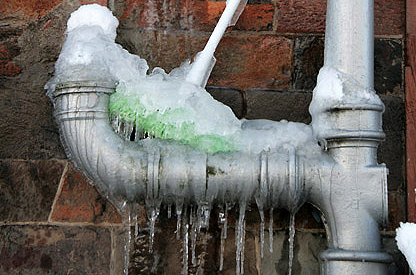Almost everyone will have their private thinking on the subject of How To Avoid Freezing Pipes.

Cold weather can wreak havoc on your plumbing, especially by freezing pipes. Here's how to avoid it from happening and what to do if it does.
Introduction
As temperature levels decrease, the danger of icy pipes increases, potentially bring about pricey fixings and water damage. Recognizing exactly how to prevent frozen pipelines is critical for house owners in cold environments.
Prevention Tips
Shielding susceptible pipelines
Wrap pipelines in insulation sleeves or use warm tape to shield them from freezing temperatures. Concentrate on pipes in unheated or outside locations of the home.
Heating methods
Maintain interior areas adequately heated, particularly locations with plumbing. Open closet doors to enable cozy air to flow around pipelines under sinks.
Just how to determine icy pipelines
Try to find decreased water flow from faucets, unusual odors or noises from pipes, and visible frost on exposed pipes.
Long-Term Solutions
Structural adjustments
Think about rerouting pipes away from exterior walls or unheated locations. Include additional insulation to attics, basements, and crawl spaces.
Upgrading insulation
Invest in premium insulation for pipes, attic rooms, and wall surfaces. Appropriate insulation helps maintain regular temperature levels and reduces the risk of icy pipelines.
Safeguarding Exterior Plumbing
Garden pipes and exterior taps
Detach and drain pipes garden hoses prior to wintertime. Install frost-proof faucets or cover outdoor taps with insulated caps.
Recognizing Frozen Pipelines
What creates pipelines to ice up?
Pipelines ice up when exposed to temperatures below 32 ° F (0 ° C) for extended periods. As water inside the pipelines ices up, it broadens, putting pressure on the pipeline wall surfaces and possibly creating them to rupture.
Threats and damages
Frozen pipelines can lead to water interruptions, home damage, and costly fixings. Ruptured pipes can flooding homes and create comprehensive structural damage.
Indications of Frozen Piping
Identifying icy pipes early can avoid them from rupturing.
What to Do If Your Pipelines Freeze
Immediate actions to take
If you presume frozen pipelines, keep faucets open up to alleviate stress as the ice melts. Use a hairdryer or towels soaked in hot water to thaw pipelines gradually.
Final thought
Avoiding frozen pipelines calls for positive measures and quick reactions. By comprehending the causes, indications, and safety nets, homeowners can safeguard their pipes during cold weather.
5 Ways to Prevent Frozen Pipes
Drain Outdoor Faucets and Disconnect Hoses
First, close the shut-off valve that controls the flow of water in the pipe to your outdoor faucet. Then, head outside to disconnect and drain your hose and open the outdoor faucet to allow the water to completely drain out of the line. Turn off the faucet when done. Finally, head back to the shut-off valve and drain the remaining water inside the pipe into a bucket or container. Additionally, if you have a home irrigation system, you should consider hiring an expert to clear the system of water each year.
Insulate Pipes
One of the best and most cost-effective methods for preventing frozen water pipes is to wrap your pipes with insulation. This is especially important for areas in your home that aren’t exposed to heat, such as an attic. We suggest using foam sleeves, which can typically be found at your local hardware store.
Keep Heat Running at 65
Your pipes are located inside your walls, and the temperature there is much colder than the rest of the house. To prevent your pipes from freezing, The Insurance Information Institute suggests that you keep your home heated to at least 65 degrees, even when traveling. You may want to invest in smart devices that can keep an eye on the temperature in your home while you’re away.
Leave Water Dripping
Moving water — even a small trickle — can prevent ice from forming inside your pipes. When freezing temps are imminent, start a drip of water from all faucets that serve exposed pipes. Leaving a few faucets running will also help relieve pressure inside the pipes and help prevent a rupture if the water inside freezes.
Open Cupboard Doors
Warm your kitchen and bathroom pipes by opening cupboards and vanities. You should also leave your interior doors ajar to help warm air circulate evenly throughout your home.

Hopefully you enjoyed reading our article on How To Avoid Freezing Pipes. Thank you for finding the time to read our content. Do you know anybody else who is fascinated about How To Avoid Freezing Pipes? Do not hesitate to promote it. We value reading our article about Prevent Frozen Pipes .
Click Here